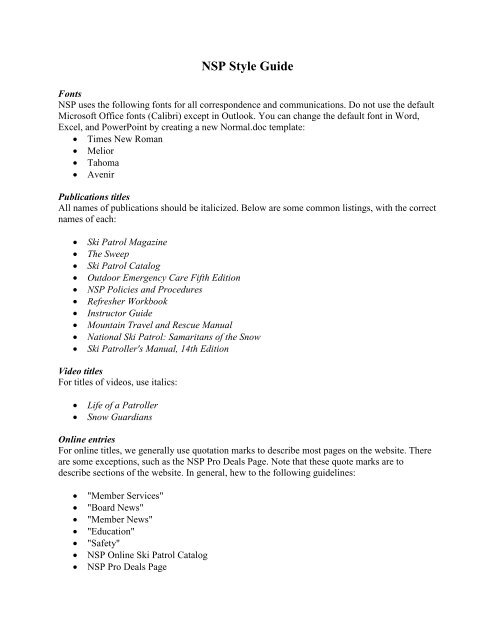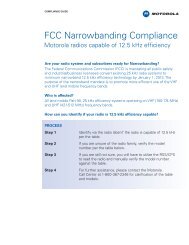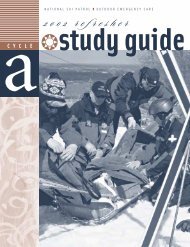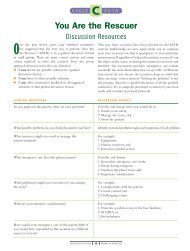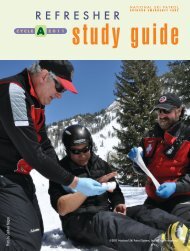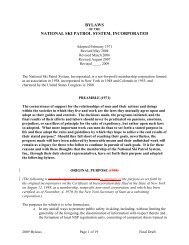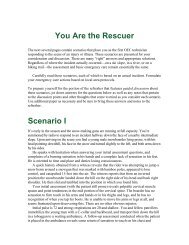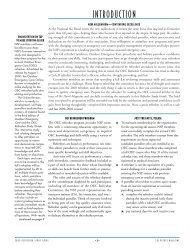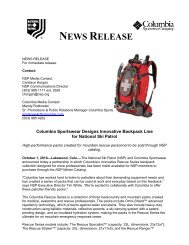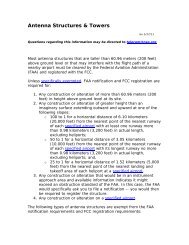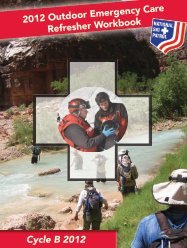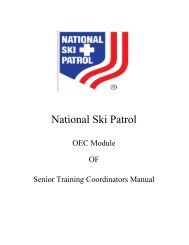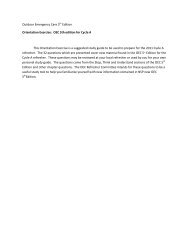NSP Style Guide - National Ski Patrol
NSP Style Guide - National Ski Patrol
NSP Style Guide - National Ski Patrol
Create successful ePaper yourself
Turn your PDF publications into a flip-book with our unique Google optimized e-Paper software.
<strong>NSP</strong> <strong>Style</strong> <strong>Guide</strong><br />
Fonts<br />
<strong>NSP</strong> uses the following fonts for all correspondence and communications. Do not use the default<br />
Microsoft Office fonts (Calibri) except in Outlook. You can change the default font in Word,<br />
Excel, and PowerPoint by creating a new Normal.doc template:<br />
• Times New Roman<br />
• Melior<br />
• Tahoma<br />
• Avenir<br />
Publications titles<br />
All names of publications should be italicized. Below are some common listings, with the correct<br />
names of each:<br />
• <strong>Ski</strong> <strong>Patrol</strong> Magazine<br />
• The Sweep<br />
• <strong>Ski</strong> <strong>Patrol</strong> Catalog<br />
• Outdoor Emergency Care Fifth Edition<br />
• <strong>NSP</strong> Policies and Procedures<br />
• Refresher Workbook<br />
• Instructor <strong>Guide</strong><br />
• Mountain Travel and Rescue Manual<br />
• <strong>National</strong> <strong>Ski</strong> <strong>Patrol</strong>: Samaritans of the Snow<br />
• <strong>Ski</strong> <strong>Patrol</strong>ler's Manual, 14th Edition<br />
Video titles<br />
For titles of videos, use italics:<br />
• Life of a <strong>Patrol</strong>ler<br />
• Snow Guardians<br />
Online entries<br />
For online titles, we generally use quotation marks to describe most pages on the website. There<br />
are some exceptions, such as the <strong>NSP</strong> Pro Deals Page. Note that these quote marks are to<br />
describe sections of the website. In general, hew to the following guidelines:<br />
• "Member Services"<br />
• "Board News"<br />
• "Member News"<br />
• "Education"<br />
• "Safety"<br />
• <strong>NSP</strong> Online <strong>Ski</strong> <strong>Patrol</strong> Catalog<br />
• <strong>NSP</strong> Pro Deals Page
In common usage, a way to write this would be:<br />
Visit "Member Services" on the <strong>NSP</strong> website and login to view the <strong>NSP</strong> Pro Deals Page<br />
and <strong>NSP</strong> Online <strong>Ski</strong> <strong>Patrol</strong> Catalog. From the "Quick Links" box on the "Member<br />
Services" page, click "<strong>NSP</strong> PRO DEALS Page," or click the "Shop the <strong>NSP</strong> Catalog"<br />
button above the "Quick Links" box.<br />
<strong>NSP</strong> Programs<br />
Avoid ampersands. Spell out on first reference; after that you can abbreviate.<br />
• Mountain Travel and Rescue Program (MTR on second reference)<br />
• Outdoor Emergency Care (OEC on second reference)<br />
• Avalanche Program<br />
• Nordic Program<br />
• Women's Program<br />
• Young Adult Program (YAP is being phased out; please do not abbreviate!)<br />
• Mountain Host Program<br />
• Alumni Program<br />
• Transportation Program<br />
• Senior Program<br />
Titles and Capitalization<br />
We follow Associated Press <strong>Style</strong> for professional title usage. In general, this means to only<br />
capitalize a title if it precedes a name; if the title stands alone, or comes after the name,<br />
lowercase it. For <strong>NSP</strong> divisions and regions, only capitalize when it is the formal title of the<br />
division or region. For committees, capitalize on first reference. For departments, use lowercase.<br />
Also, use adviser and advisers, not advisor/advisors. Board of directors is always lowercased.<br />
Here are some examples:<br />
• Executive Director Tim White (or Tim White, executive director of <strong>NSP</strong>)<br />
• education department, marketing department, communications department<br />
• Governance Committee, the committee<br />
• Eastern Division<br />
• Ohio Region<br />
• Alaska Division director<br />
• Far West Division Director Bill Gibson<br />
• <strong>NSP</strong> divisions<br />
• <strong>NSP</strong> regions<br />
• region adviser, region supervisor, region director<br />
• division adviser, division supervisor, division director<br />
• Division OEC Supervisor Janie SanRomani<br />
• Avalanche Program Director Mike Laney<br />
• <strong>National</strong> Medical Adviser David Johe, M.D.<br />
• board of directors, the board<br />
• Board Chair Burt Mitchell
• Assistant Board Chair Scott Marland<br />
• board member Larry Bost<br />
Other Capitalization Issues<br />
Capitalize ski patrol if it is a formal patrol title. Capitalize mountain host if it is a formal<br />
mountain host unit. Do not capitalize before a name.<br />
• Arapahoe Basin <strong>Ski</strong> <strong>Patrol</strong><br />
• Winter Park patroller Melanie Hood<br />
• Jackson Hole Mountain Hosts<br />
• Beech Mountain mountain host Tim Howard<br />
• The local ski patrol<br />
• <strong>NSP</strong> alumni (or alumni member)<br />
Other common terms and organizations<br />
• snow sports<br />
• telemark<br />
• Nordic<br />
• alpine<br />
• snowboard<br />
• SnowSports Industries America (SIA on second reference)<br />
• <strong>National</strong> <strong>Ski</strong> Areas Association (NSAA on second reference)<br />
• <strong>National</strong> Association of State EMS Officials (NASEMSO on second reference)<br />
• U.S. Forest Service (USFS on second reference)<br />
• <strong>National</strong> Park Service (NPS on second reference)<br />
States<br />
AP <strong>Style</strong> for all states. Lowercase "state of" constructions. Four states, Kentucky, Virginia,<br />
Pennsylvania, and Massachusetts, are technically commonwealths. Here is a list for some of the<br />
more common ones:<br />
Colo. Md. Nev. Ore. Wis.<br />
Alaska Maine N.H. Pa. Wyo.<br />
Ariz. Mass. N.J. R.I.<br />
Calif. Mich. N.M. Utah<br />
Conn. Mont. N.Y. Vt.<br />
Idaho Neb. N.C. Va.<br />
Ill. Nev. Ohio Wash.
Punctuation<br />
Punctuation could take up 30 pages. A few notes:<br />
• Hyphens:<br />
o Hyphenate compound modifiers, except the adverb very and those that end in ly;<br />
this extends to instances when the hyphenated compound modifier comes after the<br />
subject of the sentence: i.e. full-time job, the woman is quick-witted; a very green<br />
dress, 21-ounce bottle.<br />
• Possessives:<br />
o Use an 's for possessives; for proper names ending in s, just use the apostrophe,<br />
for common words ending in s, use the 's unless the next word begins with an s:<br />
girl's toys, hostess's invitation, witness' story, Achilles' heel, Dickens' novels.<br />
• Quotes:<br />
o Put all punctuation, such as periods and commas, inside quotation marks. If your<br />
quote is broken into two paragraphs, do not close quote the first paragraph, but do<br />
open quote the second paragraph, i.e.:<br />
"Does this make sense" she asked. "I hope so, because it is not that<br />
difficult.<br />
"However, I could see how the close quotes could be possibly confusing.<br />
Hopefully this second paragraph makes it clear."<br />
• Commas:<br />
o For commas, we deviate from AP and use Chicago Manual of <strong>Style</strong>. In other<br />
words, we still use the serial comma, as in: the patrol, the ski resort, and the ski<br />
area operator.<br />
Numerals<br />
In general, spell out numbers one through nine, use figures for 10 and above, when the numbers<br />
refer to a sequence in time or location. If a number starts a sentence, either spell it out, or better,<br />
rework the sentence so the number is the second word in the sentence. Use figures with percent,<br />
distance (miles/kilometers etc.), money ($5), weights (4 ounces), and ages (5-year-old girl). Use<br />
a comma in thousands. If you use th or rd in a numeral, do not use superscript.<br />
• 6 percent<br />
• The '60s, the '90s<br />
• 80 F, 5 degrees, minus 10 C<br />
• 11 a.m., 2 p.m.<br />
• $3 million, 2 billion people<br />
• 1,000, 50,000, 300,000<br />
• Page 1, Page 10<br />
• 6 pounds, 5 ounces<br />
• 5 feet 10 inches tall, 5-foot-6-inch woman<br />
• 21 years old, 30-year-old woman<br />
• Size 8 dress<br />
• 10 cents, $10<br />
• 75th
Dates<br />
Use a comma in full dates after the day and year, no comma otherwise. Abbreviate Jan., Feb.,<br />
Aug., Sept., Oct., Nov., and Dec. when used in a specific date. Avoid modifiers like th and rd in<br />
dates.<br />
• Feb. 4, 2012<br />
• February 2013<br />
• April 10, 2012<br />
• September 2013<br />
• In March 2013, the board met.<br />
• On April 10, 2014, <strong>NSP</strong>'s PEC conference will kick off.<br />
Bulleted lists<br />
We go old school; use a semicolon after each entry in a bulleted list that follows a sentence<br />
introduction. In the second to last entry, add "and" then add a period on the final line, i.e:<br />
<strong>NSP</strong> offers you:<br />
• Pro deals on gear;<br />
• Cutting-edge publications;<br />
• The best training in ski patrol operations; and<br />
• Camaraderie with other patrollers.


